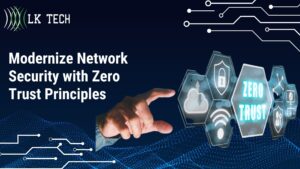Modernizing Network Security with Zero Trust Principles
Network security has evolved significantly since the days of castle-and-moat models. While strong perimeter defenses once protected on-premise assets, today's distributed IT environments require a completely new approach. Enter Zero Trust, a modern security framework that flips legacy concepts upside down.

- Modernize Network Security with Zero Trust Principles
What is Zero Trust?
Zero Trust completely reimagines network security with the motto: "Never trust, always verify." This model acknowledges that threats exist both outside and within network boundaries. So, no user or device gets trusted by default, regardless of identity or location. Instead, Zero Trust systems force all entities to continuously authenticate and authorize before accessing any resources.
The zero-trust approach stems from the reality that network perimeters have dissolved. Workforces are mobile, data lives on multiple clouds, and vendors/partners require access. Verifying each connection attempt rather than trusting pre-determined definitions of "insider" vs "outsider" provides much tighter security for modern environments.
Core Principles and Technologies Behind Zero Trust Architectures
Several key principles enable Zero Trust architectures to provide comprehensive security for modern networks:
Continuous Validation with Adaptive Access Controls
Instead of validating access at initial login only, identities and device credentials get re-checked frequently using adaptive controls. Access permissions also expire after short periods of inactivity, forcing re-authorization.
For example, an employee may use multifactor authentication when logging in from a trusted device in the morning. However, if attempting to access sensitive data after hours, another verification method may be required.
Microsegmentation and Software-Defined Perimeters
Networks divide into small, isolated zones with granular access controls between each. This microsegmentation limits potential lateral damage if any one area gets breached.
Software-defined perimeters take this further by masking network segments so they appear invisible until a device gets verified. These approaches prevent threats from moving to other parts of the network if they penetrate initial defenses.
Least Privilege Access and Just-in-Time Provisioning
Users only receive the minimal permissions necessary to fulfill their precise roles, restricting lateral movement across networks. Applications and infrastructure also follow least privilege principles.
Just-in-time provisioning takes this a step further by providing temporary credentials only when needed. For example, a developer may get access to production servers strictly on-demand rather than having permanent keys.
Continuous Device Security Validation
All devices undergo deep scrutiny with agent-based checks before joining networks to validate security postures. Ongoing traffic monitoring also helps detect vulnerabilities early, blocking compromised devices.
Checks may include OS patch levels, drivers, software versions, configuration settings, and more. Internet of Things (IoT) devices can also integrate to improve visibility across all connected endpoints.
Multi-Factor Authentication and Passwordless Login
Users provide multiple proofs of identity like passwords plus one-time codes or security keys for each session. This mitigates risks from stolen credentials.
Passwordless solutions using biometrics and security keys strengthen this further by eliminating static passwords entirely. With passwordless, credentials get cryptographically tied to individual users to ensure legitimacy.
Key Benefits of Adopting a Zero Trust Approach
Together, these tenets minimize attack surfaces, improve threat detection, and reduce breach impacts. While complex on paper, modern tools like Cloudflare's Zero Trust platform greatly simplify adoption. The benefits for modern enterprises are immense:
Reduced Third-Party Security Risks
Historically, connecting with vendor systems meant either limited integration or the opening of virtual connections through secure firewalls. Zero Trust principles enable much more fine-grained control over these third-party connections.
Granular access policies can be applied per user, per device, per application used, and even to specific data. This provides a free flow of essential information with partners while limiting exposure.
Accelerated Cloud and Hybrid Environment Adoption
Legacy network security models like VPNs hamper cloud adoption with performance issues or availability gaps. Zero Trust architectures unified security policies across cloud, on-prem, and hybrid environments.
With consistent controls and visibility everywhere, organizations can migrate faster and enable seamless collaboration between environments. Zero Trust platforms make unified security across complex hybrid networks achievable.
Frictionless Experience for Remote Employees
The work-from-anywhere economy requires secure remote access at scale. Zero Trust principles like contextual access controls and device security checks power modern remote connectivity.
Employees get seamless authenticated access to all their required resources from any device or location. IT teams gain consistently enforced security everywhere without hampering productivity.
Reduced Breach Impact and Lateral Movement
Forrester Research estimates that up to 80% of breaches involve lateral movement across networks post-compromise. Zero Trust architectures impede these tactics via micro-segmentation, the least privilege access, and strict device validation.
If adversaries penetrate one sub-zone, they have limited ability to pivot deeper internally. This gives security teams precious time to detect intrusions and respond before major damage occurs.
The Inevitable Future of Zero Trust Security
Given its effectiveness in modern environments, Zero Trust security principles seem destined to become the new norm for network security. In a landscape with proliferating users, devices, clouds, and threats, "never trust, always verify" offers the most prudent path forward.
High-profile breaches will continue raising awareness of Zero Trust in leadership teams. And early adopters are already reporting major risk reduction, cost savings, and productivity gains.
As tools mature, Zero Trust architectures will permeate enterprise environments:
- Critical systems will integrate the least privilege controls and passwordless access
- Microsegmentation will divide networks into isolated safe zones
- Cloud migrations will accelerate with consistent security everywhere
- Third-party connections will use granular, context-aware access controls
- Devices will undergo continuous conditional access evaluations
In essence, the entire concept of network perimeter will disappear as dynamic identity and context drive security. For organizations looking to enable digital transformation securely, Zero Trust promises the most advanced approach yet.


